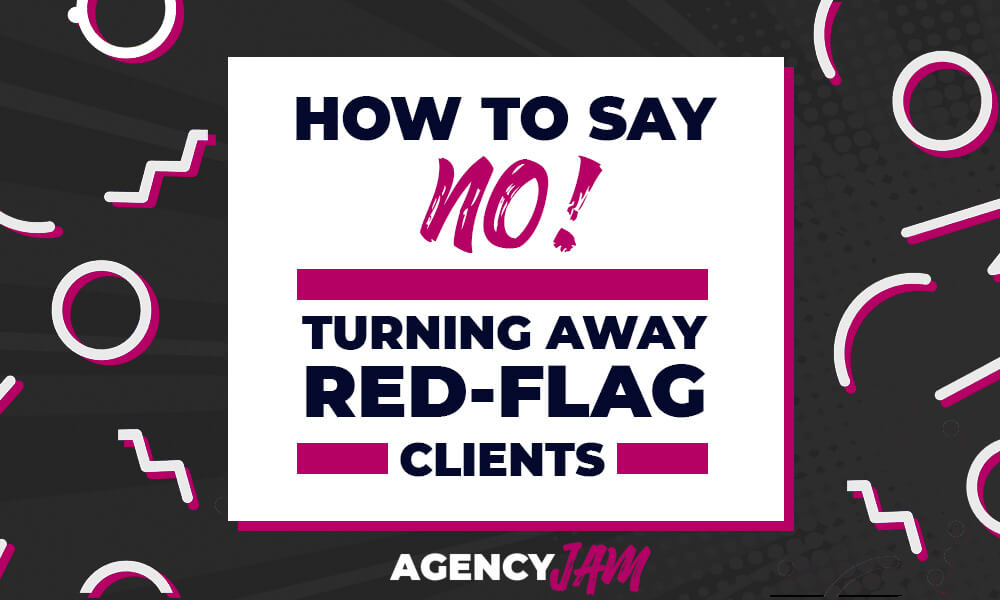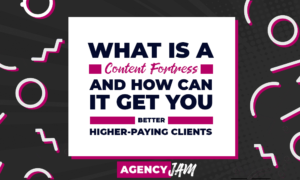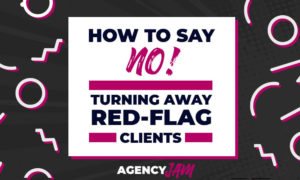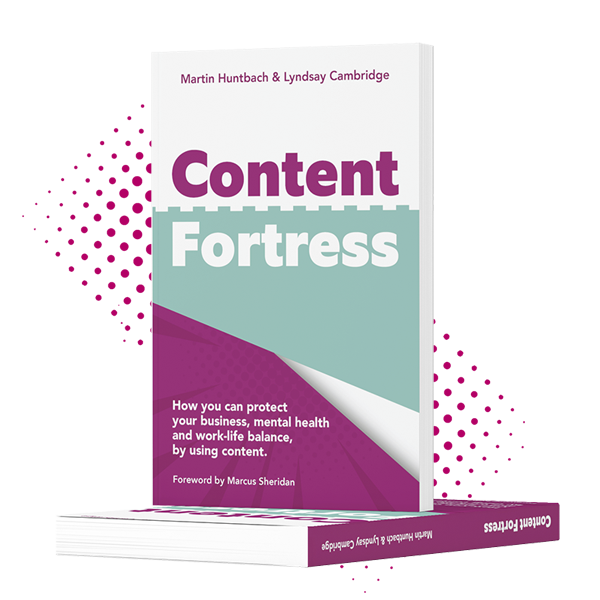How to say NO to clients who are the wrong fit for your agency

You know that feeling you get when you know a potential client just isn’t right?
There are a few ‘red flags’.
They mention they’ve had trouble with previous agencies.
They might say, ‘oh it won’t take you long to do XYZ.’
Or they may say, ‘I’m on a tight budget and have a tight deadline.’ – oh wow, double the fun.
The problem is, you’ve already spent hours (or even days) communicating with them.
Phone calls, back and forth emails, creating proposals, or even, giving away your ideas for free.
You know deep down, that this client isn’t right for you.
But you’ve come this far, right? And you can see the money in sight. So you take the money and the project and what happens?
You end up with a client that causes you nothing but stress.
We’ve been there, and we can categorically say that it is the absolute WORST.
How to repel the wrong fit clients
Wouldn’t it be better if we had a process for REPELLING those the wrong-fit clients?
A way of stopping people from getting in touch in the first place?
A way of pre-qualifying leads without having to speak to them, at all?
Or even better, what if there was a way to educate them and make them understand that YOU are the expert, and the way that you do things is going to give them the best chance of success.
Or educate them so that, even if they’re not the right client for your now when they’re ready they’ll only ever go to you.
In this article, we’re going to tell you exactly how to do that.
But First Thing’s First: Why Would You Want to Turn ‘Bad Clients’ Away?
Alright, so you might think, ‘so the project will be a bit more stressful – big deal! I can handle it and I need the money.’
But actually, taking on the wrong clients can have a real negative impact on both you and your business.
Let’s look at some of the implications of taking on ‘bad clients’. (When we say ‘bad clients’ we mean clients that aren’t the right fit for us. We’re not calling them bad people!)
1. The Amount of Time You Spend With Wrong-Fit Clients
The time it takes working with a bad client vs a good client is drastic.
We looked back at our previous projects and found that on average the “bad” client projects took around 3x longer to complete than the “good” clients did. The reasons for this were…
- There were huge delays whilst waiting for things from these clients (like web copy)
- They needed far more email communication
- They took up more time on phone calls, videos calls and face to face meetings
- Scope creep became an issue sometimes – extending the length of the project
There’s no doubt that taking on the wrong type of client takes more time.
But it was only after we looked back at our own projects did we realise just HOW MUCH MORE time was wasted working the “bad” clients.
2. You Have to Battle With Who Has the Authority
Some bad clients like to try and take control of the project. They think they know best and try to manage you like they would an employee.
It’s incredibly frustrating when this happens, and it feels like you’re working a job with a boss. This is why it’s so important to look out for those red flags before taking them on as a client. If not you could end up…
- Working longer hours to meet their deadlines
- Putting off other projects because you’re feeling under pressure from them
- Delivering a sub-par product because they have micromanaged the process and have not taken your advice on board
3. Bad-Fit Clients Impact Your Profit Margins
Working with bad clients can have a huge impact on your profit margins. We’ve already told you that bad clients take on average 3x longer than good clients. They might even hold back payments until they’re “happy with the progress.”
All of these things will impact your mental health as well as your bank account. Taking all that into account, working with bad clients leads to:
- A lower hourly rate
- Cash flow issues
- Stress and anxiety that impacts your other client projects
You can’t run a successful business if you’re struggling to make money, and you can’t help your clients get the better results if you’re not being paid what you’re worth.
It’s far better to not take them on as a client in the first place.
Who should you turn away?
Now that you know how damaging bad clients are to your business, now we’re going to talk about how to spot them so you don’t get caught out. You may think this is obvious (and in some cases it is). But actually, some really lovely polite people also aren’t the right fit for your business!
The Enemy
We have all received emails and phone calls from “the enemy” before and it’s not fun dealing with them. This type of person can be cold, arrogant and maybe even a little aggressive.
For example, they may say.
I need a new website that ranks on page one of Google and I need it fast.
What’s the cheapest this can be done?
Call me if you have the skills to do this.
Barry – 07632…
I don’t know about you, but this person doesn’t sound like the best type of client in the world. And that’s putting it nicely.
The Damsel
There are some leads that come through from polite, friendly people. These are far from the arrogant, bossy ones like the Enemy, however, they still might not be the right fit for your agency.
We call these people “the Damsels”. The one thing about these clients that make them a “wrong fit” is that they are not ready for your products and services. Perhaps they like you, your brand and your content and they decide to get in touch. This does not automatically make them a good client.
As an agency owner we found that these were a few of the red flags of Damsel:
- “I’ve only just started my business.”
- “I don’t have a lot of money to invest.”
- “I don’t really know who my audience is yet.”
- “I have this brand new idea for a product/service.” (when they haven’t tested it.)
This type of client is different for everyone. For us, it used to be those who didn’t want to ‘touch’ their websites, who weren’t interested in updating it themselves at all. They wanted someone to manage that entire thing for them – not great for us (we just didn’t have the time) but this person could be perfect for another agency.
It was also new business owners as we found they weren’t quite ready for a website and needed a lot of time and hand-holding.
You’ll have to make note of your own “red flags” that might cause issues later down the line. It’s much better to repel these clients before they take up your time.
The Time Waster
We once had someone take up two hours of our time on a video call asking questions about our prices and processes, discussing their business and what direction they should go in. They seemed super keen to work with us. We sent them a proposal and…you guessed it! We never heard from them again.
After this happened, I implemented a “Circuit breaker” for phone calls. In the electric world, a circuit breaker is something that STOPS all electricity if it believes something is going wrong or if it’s becoming UNSAFE.
How does this apply to phone calls with clients? Well anyone who calls who you perceive to be a time-waster, give yourself something to say that breaks the conversation and saves you from wasting any more time on the call. Even if they are still talking I simply stop them and say…
“…That makes total sense, also. Just so you know. I have another call in 2 minutes with a client so I’m going to have to end it here. BUT, I’m going to email you with some important information that will answer your questions and will give you a better idea of what to expect when working with us. What’s the best email to send it to?”
And that’s it. This 20-second script has since saved me so many hours of time that I would never have got back.
So hopefully now, you should have an idea of how to spot the bad clients and now we’re going to talk about how to turn bad clients away and feel comfortable saying NO!
How to turn away ‘wrong fit’ clients
Knowing how to turn these enquiries away seems to be one of the biggest struggles for agencies and freelancers. This is usually a battle between money now vs more time/more earning potential in the future.
And even if you do want to say NO to working with a client, how the hell do you do it?
Here is exactly what we do.
Use content
Delivering bad news to a prospect i.e. “no, I don’t think I can take you on as a client” is REALLY scary. Even for us.
This is why we create content that explains who we work with and who we’re not the right fit for. We have written lots of blog content that teaches people about who we are, how much we charge and what we expect from the client if they work with us.
When someone is on your website consuming your content, they might stumble across one of your articles and start to understand more about you, your processes and prices. This will help them understand if they are the right kind of client for you.
If they are, this will make the sales call a lot easier.
If they are not, they will never get in touch in the first place.
Win-win.
Here are 3 pieces of content you can create to help you do this.
- How much do we charge for a website?
- Are we the right agency for you?
- Mistakes people make when hiring a design agency
These articles are a great starting point to educating your website visitors BEFORE they get in touch.
Use emails
Understandably, not everyone will read all of your content before getting in touch and that’s exactly why we implemented an “Email Test” as part of our Content Fortress.
This means that every single enquiry that comes through our website will receive a very similar email in reply. This email will allow you to filter out the bad-fit clients from the good, and save you a lot of wasted time.
And the best thing, you can copy our template from below.
Email Templates That Pre-Qualify Clients
Imagine you receive an email. And it seems like they might be an “Enemy” and you’re not sure how to reply.
Here’s the example from earlier…
“I need a new website that ranks on page one of Google and I need it fast.
What’s the cheapest this can be done?
Call me if you have the skills to do this.
Barry – 07632”
At this point, you don’t know if they are a good or bad client. They might just be bad at emails. This is why you NEED an email template to send to these kinds of enquiries. You’ll need to do this before you send them packing.
There are countless times when we’ve thought, there’s no way this client it going to be a good fit, when actually, they just haven’t come across well via email.
The point is, you’ve gotta pre-qualify them first.
I would use this email to reply…
The Email Test: Approached by The Enemy
“Hi Barry,
Thanks so much for getting in touch.
It’s great that you’re looking to get a new website and drive traffic from Google.
We may be able to help you. But it would be good to see if we’re the right fit.
To help you understand more about us and how we work, I’ve shared a few links below that will really help.
We always find the more knowledge you have going into this, the more chance you will have a return on your investment.
Article 1 – What makes a great website
Article 2 – Most common mistakes when hiring a web designer
Article 3 – How much we charge for web design
Article 4 – What we expect of you in the web design process
Please take a look at these and let me know if you have any questions.
Thanks again
Martin”
After they receive this, two things are likely to happen.
You never hear from them again, which is a good thing because they clearly are not the right fit.
They email you back and sound like a completely different person. They might even apologise for being blunt and be really nice to you.
On the rare occasion, they may not read your content but email you back being even ruder (it’s rare, don’t worry).
If it’s they do email back even ruder than before, you should reply with an email similar to this:
“Hi Barry,
I’ll be honest, I don’t think we’re the right fit for the project.
As I said, it takes a certain type of approach to have a successful website and it wouldn’t be fair on your to invest in something if it’s not going to deliver a return on your investment.
It might be best to have a look around for another agency who can work to your requirements.
Best of luck going forward.
Thanks
Martin’
I know that might seem a little blunt but it’s best to send it and move on…
The Email Test: Approached by the Damsel
Getting an email enquiry from someone who is friendly is a lot harder to turn away than someone who is rude. An email from them might look like this
“Hi Martin,
Love your website.
I’m actually looking to hire a web designer and I’d love to arrange a call to talk about working with you.
I’m just starting my business after being employed for 30+ years! I don’t have a lot of money to invest, and I am a bit clueless when it comes to websites and social media and stuff so I have a few questions.
Can we arrange a call to talk about all this?
Thank you
Peter”
So as you can see, this is a very friendly enquiry but this person might not be ready for your services right now.
How do we know? He said…“He’s starting a business”, “Not much money”, “I’m clueless.”
At this point, you can send one of the following two emails.
Email one
“Hi Peter,
Thanks so much for your email and I’m so glad you like our website.
And thank you for telling me more about your situation, the more information we have the better.
We have actually written a few articles that will help you understand if we’re the right agency for you at this stage in your business.
Article 1 – How much we charge for a website
Article 2 – Our step by step process for building websites
Article 3 – How to find the right web designer for you
Even if we can’t help at this stage, I know these articles will help you hire an agency who is right for you.
If you have any questions, don’t hesitate to ask.
Thanks so much
Martin”
Email Two: Educating your Damsel until they are ready to work with you.
We try to create content that educates people who aren’t quite ready for our services as yet (but could be in the future). For example, one of the most popular blog posts on our agency website was: Why New Businesses Shouldn’t Invest Thousands in a Website.
We would send this content to the prospect if they were a new business. It would look something like this…
“Hi Peter,
Thanks so much for your email and I’m so glad you like our website.
Your new business venture sounds very exciting!
We’re very much about honesty here, so we generally recommend that new business owners don’t invest thousands in a new website. You can find out why in an article we published below…
Why New Businesses Shouldn’t Invest Thousands in a Website
This is absolutely nothing personal to you but is based on our experience. And we feel we’d be doing you a disservice if we didn’t explain this to you upfront.
However, if you’re thinking of DIYing your website, we would recommend the following company…
[insert recommendation]
And in the meantime, you can sign up to our newsletter which will give you so many hints and tips on how to create a successful website.
Wishing you all the best with your new and exciting business.
Many thanks
Martin”
We’ve done this many times, and not one person has had an issue with it. In fact, the majority of people have got back to us thanking us for our honesty. And better still, we’ve found that some of these people have come back to us when they’re in a position to buy – because why would they trust anyone else, right?
What Are Your Next Steps?
If you found this useful, then you might want to check out our book. We have lots of other content ideas and email templates like these that you can use with all different types of clients.
In the book, we also have content that will help you sell more of your services so you can make more money.
Want some more?
Of course you do. Check out these articles...

What is a Content Fortress and how can it help your agency get better, higher-paying clients?

Why Every Agency Needs to Create ‘Sales Content’ (and how to do it)


How to Use Content to Transform Prospects into Your Dream Clients



